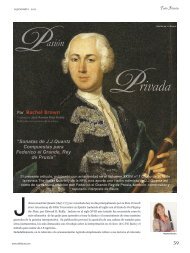Telemann Fantasias article + music - Rachel Brown
Telemann Fantasias article + music - Rachel Brown
Telemann Fantasias article + music - Rachel Brown
You also want an ePaper? Increase the reach of your titles
YUMPU automatically turns print PDFs into web optimized ePapers that Google loves.
2<br />
15<br />
!" ## " # ###<br />
# $ # # # # $ # # # " #<br />
# $ #<br />
# # # $ # # # ### # ### # # $ # #<br />
$ # # # % # # # # # # # # # # # #<br />
# # # $ # ##<br />
# ###<br />
#<br />
## $ # ##<br />
#<br />
Subj.<br />
! " # $#<br />
# " # #<br />
#<br />
# & & # $<br />
Counter subject<br />
#<br />
# "#<br />
& & # $ # $# #<br />
# # ## $ # ' ' %<br />
# # # # # ! # # # # ! # # # # # # $ # # '<br />
' ' (<br />
'<br />
stretto: Subject<br />
22 # # # # # # # #<br />
!" % # # # #<br />
# #<br />
# $ # # #<br />
# # # #<br />
#<br />
# # $ # # #<br />
#<br />
p<br />
! "<br />
'<br />
%<br />
p<br />
!<br />
# # # # # # #<br />
'<br />
!<br />
# # !<br />
# # # # # # $ # # '<br />
'<br />
(<br />
'<br />
f<br />
#<br />
# $ # #<br />
Subj.<br />
!<br />
# # #<br />
# $ # # $ #<br />
&<br />
#<br />
# $ #<br />
& &<br />
#<br />
&<br />
#<br />
&<br />
Counter subject<br />
# $<br />
f<br />
stretto: Subject<br />
# $ #<br />
28<br />
! " # # # # #<br />
) # # # # # # # #<br />
# # # " # # $ # # #<br />
# # # # $ # ) # # #<br />
# # # # $ # # # # # #<br />
!" # ) # # # # # "# # # $# # #<br />
Ex.14 <strong>Telemann</strong> Fantasia in D minor, Allegro<br />
retrograde subj.<br />
# $# #<br />
%<br />
# # # # # # # # # # #<br />
$ #<br />
# #' #<br />
# $ # # # # # $ # # # $ # #<br />
# # # &<br />
#<br />
retrograde subj.<br />
# * #<br />
# # $# #<br />
+<br />
%<br />
#<br />
# #<br />
+<br />
* # #<br />
#<br />
Though none are labelled as such, many movements are composed in various forms of<br />
the dance suite, so popular at the time, and so easily recognisable to the eighteenthcentury<br />
public. The tempo markings, therefore, may be seen as confirmation,<br />
qualification or modification of the norm. The F# minor A tempo giusto is an Italian<br />
Corrente, to be played ‘at the conventional speed’ with flowing quaver motion in 3<br />
time and the typical opening gesture, whereas the following Presto is noticeably<br />
speedier than a normal Gavotte, with crotchet motion commencing half-way through<br />
the bar. According to Quantz a Gavotte would traditionally be played a little slower<br />
than a Rigaudon or Bourée which would be bar (�) = 80.<br />
In his book, Versuch eiener Anweisung die Flöte traversiere zu spielen (Berlin, 1752),<br />
Quantz laid down guidelines for various tempi, measured (before the invention of the<br />
metronome) by the pulse beat of a healthy person, taken after lunch! He calculated<br />
this as 80 beats per minute, though he admitted “I do not pretend that a whole piece<br />
should be measured off in accordance with the pulse beat; this would be absurd and<br />
impossible”. A speed of � = 80 for the pieces in the style of a Rigaudon or Bourée,<br />
such as the A minor Allegro or the E major Vivace would be ambitious! Quantz<br />
suggests they should be played gaily, using a light bow-stroke. The Vivace marking<br />
suggests a lively but less hurried speed.<br />
# &<br />
#<br />
&




